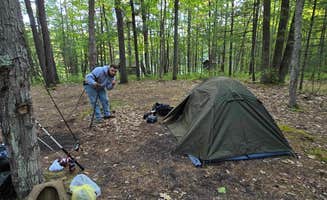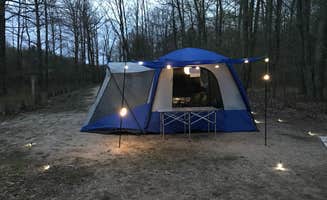Dispersed camping near Grayling, Michigan provides access to over 300,000 acres of public lands across multiple state and national forests. The area sits at elevations ranging from 800-1,300 feet above sea level, creating unique topography for Michigan's Lower Peninsula. Most sites experience temperature swings of 30-40 degrees between day and night during spring and fall camping seasons.
What to do
Wildlife viewing opportunities: At Pigeon River State Forest dispersed camping, campers can observe Michigan's only wild elk herd, particularly during fall rutting season. The forest houses over 1,000 elk across its 100,000+ acres, with dawn and dusk offering the best viewing times.
Fishing access points: Numerous dispersed sites provide direct river or lake access. The De Cheau Lake Camping area offers excellent fishing opportunities in a secluded setting. One camper noted, "Feels more remote than it really is. Lots of room for multiple vehicles/sites. Very near a handful of private residences."
Multi-day hiking routes: The loop formed by connecting the North Country Trail and Manistee River Trail creates a 20-mile circuit ideal for weekend backpacking. One visitor to Huron-Manistee National Forest explained, "I love this loop trail because you can hike in and out without having to backtrack or coordinate a ride back to your parked car."
What campers like
Secluded lakeside camping: Multiple lakes across the region offer primitive camping with direct water access. At Sand Lakes Quiet Area Backcountry Campsites, a visitor shared, "great spots near lakeside, hiking nearby, quiet, hardly saw anyone." The area features several small lakes connected by hiking trails.
Wildlife encounters: The forests surrounding Grayling provide frequent wildlife sightings. As one camper at De Cheau Lake described, they were "blessed by the Elk bugles nearby" during their stay, highlighting how proximity to wildlife enhances the camping experience.
River access: Many dispersed sites sit along riverbanks offering both recreation and practical water access. A visitor to Huron-Manistee noted, "The River trail supplied us with our water needs for cooking and drinking, from the Manistee River." This resource reduces the need to carry large water supplies when backpacking.
What you should know
Navigation challenges: Finding specific dispersed sites can require extra preparation. Regarding Sand Lakes Quiet Area, one camper advised, "We struggled to find this place and knew with the reviews it was possible. We ended up googling it on Google maps because the location on here was off."
Permit requirements vary: While some areas require Michigan Recreation Passports, others have different regulations. At Goose Creek Trail Camp, permits are required for overnight stays, with self-registration typically available on-site.
Seasonal considerations: Weather impacts site accessibility significantly from late fall through spring. Unpaved forest roads can become impassable after heavy rain, and seasonal closures affect certain areas between November and April. Many water sources become unreliable during late summer.
Tips for camping with families
Best introductory sites: For families new to dispersed camping, certain locations offer more amenities. Goose Creek Trail Camp provides established sites with fire pits and picnic tables. A visitor noted it's a "Rustic state forest campground located near trails. Each site has its own fire pit and picnic table."
Kid-friendly fishing spots: Several lakes feature shallow areas ideal for young anglers. At Cut River Dispersed Campsite, the gradual shoreline provides safer water access for children compared to steeper riverbank locations.
Noise considerations: Some sites experience unexpected noise despite remote locations. A visitor to Sand Lakes noted, "To many people and yelling kids but breath taking for sure," suggesting families should prepare for varying levels of quietude even in designated quiet areas.
Tips from RVers
Access limitations: Most dispersed sites near Grayling have significant vehicle restrictions. While Cut River Dispersed Campsite can accommodate larger rigs, most forest roads limit vehicle size due to tight turns, low-hanging branches, and uneven terrain.
Self-sufficient setup requirements: No hookups exist at any dispersed sites in the region. RVers must arrive with full water tanks, empty waste tanks, and sufficient battery/solar capacity for their stay duration. Most sites restrict generator use to limited hours if allowed at all.
Turnaround space considerations: Forest roads often lack proper turnaround areas for longer vehicles. Many campers recommend scouting potential sites without your trailer first before committing to narrow access roads.



